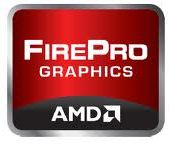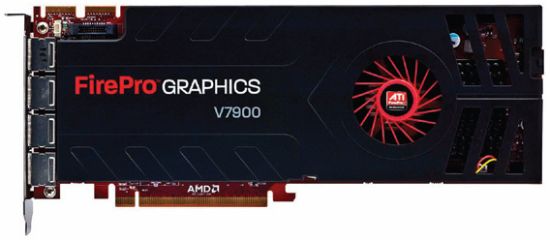

AMD FirePro V7900 has joined the family of AMD professional graphics cards. This new FirePro card is based on the third generation of 40nm GPU (formerly codenamed Cayman – what is the new codename?). This GPU features 1280 SP (Stream Processors) and 2048MB of GDDR5 memory.
A Radeon HD 6970 (Cayman) has 1536 SP, while a HD 6950 (Cayman) has 1408 SP. The difference between HD 6970 and HD 6950 is 128 SP or 2 SIMDs (one SIMD = 64 SP). The same kind of difference exists between the HD 6950 GPU and FirePro V7900 GPU: 1536-1280 = 128 = 2 SIMDs. At first approach, you can consider the V7900 like a limited version of HD 6950.
Of course some features like frame lock (synchronization of color buffer swaps across multiple systems) are not supported by AMD gaming cards. One other cool feature I’d like to test one day is the CrossFire Pro that makes it possible to enable CrossFire support for windowed applications. With gaming cards, CrossFire is only supported in fullscreen mode.
The V7900 supports OpenGL 4.1, Direct3D 11 and OpenCL 1.1. The VGA cooler takes only one slot and the TDP (thermal design power) is 150W. The PCB embarks one additional 6-pin power connector.
AMD FirePro professional graphics have been engineered to deliver innovation and reliability for a wide range of professional operating environments, including Windows® 7, Windows XP, Windows Vista and Linux. The unifi ed driver, which supports all
AMD FirePro workstation products, helps reduce the total cost of ownership by simplifying installation, deployment and maintenance.New for this generation of AMD FirePro products is AMD Powertune technology. This state-of-the-art power management technology provides direct control over GPU power usage. Applications enjoy ultimate performance with dynamic clock optimization, while keeping your workstation energy-conscious and helping to conserve electricity when it isn’t needed.
In addition, AMD FirePro products incorporate AMD’s unique AutoDetect technology. As users open new 3D applications, or move between them, optimized AMD FirePro graphics driver settings are automatically confi gured for maximum performance, no matter what the user’s workfl ow demands.
Also new for this generation of AMD FirePro products is GeometryBoost technology. GeometryBoost is a unique hardware capability that processes two primitives per clock cycle. What this means is incredibly fast geometry performance, ensuring smooth handling of complex models.
More details about the FirePro V7900 are available in the datasheet HERE.
FirePro price is main a maketing thing no?
It’s mainly driver’s features wich is the reason for “professionnal prices”. No?
FirePro, the poor mans workstation card.
you get what you pay for.
GeometryBoost might be an interesting boost
@Squall Leonhart: I smell a NVidia fanboy; FirePro V7900 is a very powerful pro card, trust me.
@WacKEDmaN: “GeometryBoost might be an interesting boost”
While Cayman can process two primitives per clock, it does not parallelize the rest of the pre-setup pipeline. Things like view-port transform, clipping, culling & etc. are still processed in a serial manner, representing a potential bottleneck. Fermi-based Quadros (the direct competitor to FirePro)have the capacity of up to four primitives per clock and on top of this the geometry workload is spread across the SM units, incl. the tessellation stage.
@Bulldozer
The product is only as good as its drivers, and FireGL’s provide a world of hurt for fast copies and npot.
@fellix: you are incorrect as all clipping, culling, tessellation etc. execute in parallel.
@Todd – of course it is… however look at that:
Cypress – 1x vertex, 1x tess, 1x geometry, 2x scan conversion
Cayman -> 2x vertex, 2x tess, 2x geometry, 2x scan conversion
Fermi -> 16x vertex, 16x tess, 16x geometry, 4x scan conversion
Something might be not exactly as I wrote here, but again, not everything on AMD has direct equivalent on NV. Fermi is a beast, very powerful beast. GF100 or 110 doesn’t win in every game and it’s potential is rarely utilized there, but in professional apps it has great advantage over AMD products.
@Promilus: I don’t dispute that Fermi is a powerful chip, but not all Quadro chips are fully enabled Fermi’s and in the end it will be price, measured performance, and other factors that matter to consumers.
@Squall Leonhart: I smell a NVidia fanboy; FirePro V7900 is a very powerful pro card, trust me.
Trust me, I suspect it is not.
I have V7800. The “power” is very limited in few application, in others like modern picture-viewers, Photoshop 3D support any regular 3-4 year old Nvidia consumer card can beat it due to its crappy drivers- DirectX support specifically. There are few threads in internet about this memory mapping issue 🙁 You would not expect to find out that it can hardly able to move image in PS despite 2GB memory. This is not what to expect from “professional workstation card” 🙁
Guys
What are your opinions regarding this test ???
Real life -$/$
Ps. i am just shopping of a pro card, which hopefully will last me few good years !!
Thanx and Merry Christmas all 🙂
Jaanos is right
I have v7900 and the reason to bye this card was to accelerate viewport in 3ds max 2012.
I also have a Radeon HD 6870 but there is really no difference between them in 3ds max.
I just waste my mony on this 🙁